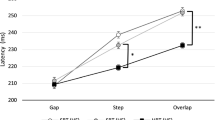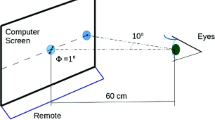Abstract
Latencies of eye movements to peripheral targets are reduced when there is a short delay (typically 200 ms) between the offset of a central visual fixation point and the target onset. This has been termed the gap effect. In addition, some subjects, usually with practice, exhibit a separate population of very short latency saccades, called express saccades. Both these phenomena have been attributed to disengagement of visual attention when the fixation point is extinguished. A competing theory of the gap effect attributes it to disengagement of oculomotor fixation during the temporal gap. It is known that auditory targets are effective in eliciting saccadic eye movements, and also that covert attention operates in the auditory modality. If the gap effect and express saccades are due to disengagement of spatial attention, both should persist in the auditory modality. However, fixation of gaze is largely under visual control. If the gap effect results from disengagement of fixation, then at least a reduced effect should be seen in the auditory modality. Human subjects performed the gap task and a control task in the dark, using auditory fixation points and saccadic targets, on five successive days. Despite this practice, express saccades were not observed. There was a reliable gap effect, but the reduction in saccadic latency was only 17 ms, compared with 32 ms for the same subjects in the visual modality. This suggests that about half the gap effect is due to disengagement of visual fixation. The remainder was not due to non-specific warning effects and could be attributed to offset of the auditory fixation stimulus.
Similar content being viewed by others
Author information
Authors and Affiliations
Additional information
Received: 1 March 1996 / Accepted: 11 July 1997
Rights and permissions
About this article
Cite this article
Shafiq, R., Stuart, G., Sandbach, J. et al. The gap effect and express saccades in the auditory modality. Exp Brain Res 118, 221–229 (1998). https://doi.org/10.1007/s002210050275
Issue Date:
DOI: https://doi.org/10.1007/s002210050275




